To visit - Budapest
Budapest, the Pearl of the Danube, captivates travelers with its enchanting blend of history and modernity. Its majestic bridges, such as the Széchenyi and Chain Bridge, offer panoramic views of a city with striking contrasts. Thermal baths, like the famous Gellért Baths, beckon for a welcome relaxation after a day of exploration.
The cobblestone streets of the Castle District transport visitors through the ages, revealing the medieval soul of the city. Iconic cafes, like the New York Café, awaken the senses with their sumptuous architecture and timeless ambiance. Hungarian cuisine, featuring dishes such as goulash and kürtőskalács, delights the taste buds and embodies local authenticity.
Concerts in ruin bars, the vibrant nightlife of the Jewish Quarter, and cultural festivals liven up the evenings. The illuminated Parliament building at night symbolizes the architectural and political grandeur of the country. Lively markets, like the Great Market Hall, provide an immersion into daily life and local flavors.
Budapest, with its undeniable charm, becomes an invitation to travel, a dance between the past and present that leaves a lasting imprint in the hearts of travelers.
The 13 essential things to do in Budapest :
Summary
- To visit
-
- 1 - Explore Buda Castle and Fisherman’s Bastion
- 2 - Walk across the Chain Bridge to enjoy the view of the Danube.
- 3 - Visit Heroes’ Square
- 4 - Relax in thermal baths, such as Széchenyi or Gellért
- 5 - Explore the Great Covered Market (Nagycsarnok)
- 6 - Discover the Dohány Street Synagogue and the Jewish Quarter
- 7 - Admire the architecture of the Hungarian Parliament.
- 8 - Visit the Cave Church (Sziklatemplom)
- 9 - Gain height at Gellért Hill for the panoramic view
- 10 - Spend time on Margaret Island to relax
- 11 - Take a cruise on the Danube to see the illuminated monuments
- 12 - Experience the unique nightlife of ruin bars, like Szimpla Kert
- 13 - Enjoy a performance at the Hungarian State Opera
- Budapest - Where to Stay?
- Budapest - How to get around?
- Budapest - Best period
1 - Explore Buda Castle and Fisherman’s Bastion
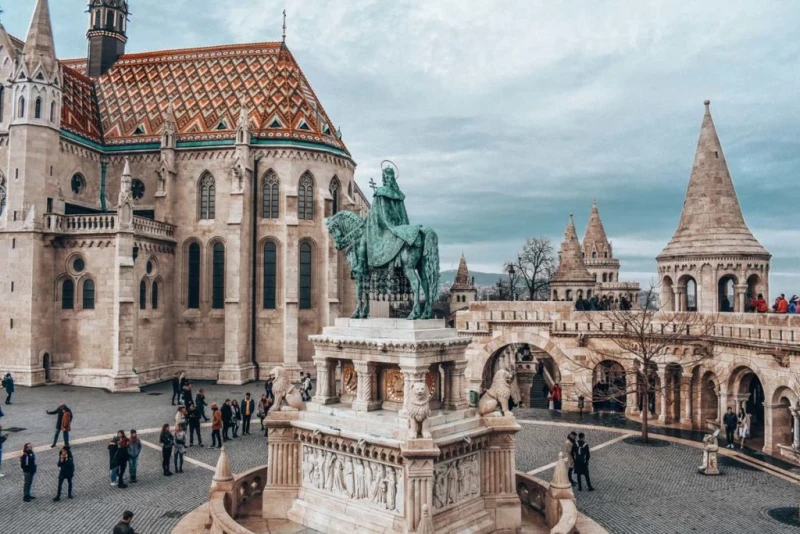
The Buda Castle and Fisherman's Bastion are two iconic sites located in Budapest, Hungary, on the west bank of the Danube River. These attractions offer breathtaking views of the city and are architectural gems steeped in history.
Buda Castle (Budavári Palota):
-
History: The Buda Castle has a history dating back to the 14th century and served as the seat of various Hungarian rulers. It underwent numerous reconstructions over the centuries.
-
Architecture: The castle combines Gothic, Baroque, and Neo-Romanesque elements. The inner courtyard and castle square are particularly picturesque.
-
Museums: Inside the castle, you'll find several museums, including the Budapest History Museum and the Hungarian National Gallery, which houses a rich collection of Hungarian art.
-
Matthias Church: Nearby, don't miss the stunning Matthias Church, known for its Gothic architecture and colorful tiles.
Fisherman's Bastion (Halászbástya):
-
Architecture: Built in the early 20th century, Fisherman's Bastion is a Neo-Romanesque monument offering panoramic views of Budapest.
-
Symbolism: It gets its name from the fishermen who once defended this part of the ramparts. The bastion consists of seven towers, representing the seven Hungarian tribes that founded the country.
-
Terraces: The bastion's terraces provide a spectacular view of the Hungarian Parliament, the Danube River, and Pest. It's an ideal spot for taking photos.
-
Bronze Statue: You'll also find an equestrian statue of the first Hungarian king, Saint Stephen, at the entrance of Fisherman's Bastion.
Exploring Buda Castle and Fisherman's Bastion allows you to delve into Budapest's fascinating history while enjoying unforgettable panoramic views of the city.
 Our tips for getting the most out of your experience.
Our tips for getting the most out of your experience.
here are some tips for exploring Buda Castle and Fisherman's Bastion in Budapest:
Buda Castle (Budavári Palota):
-
Planning: Start your visit early in the morning to avoid crowds. The castle is often quieter in the early hours.
-
Combined Tickets: If you plan to visit multiple museums inside the castle, consider purchasing a combined ticket to save on entrance fees.
-
Guided Tour: For a more enriching experience, consider joining a guided tour. Guides can provide in-depth historical and cultural information.
-
Castle Gardens: Don't miss the castle gardens, offering a peaceful escape with stunning views of the city.
Fisherman's Bastion (Halászbástya):
-
Time of Day: Mornings and evenings offer a quieter atmosphere and breathtaking views, while the sunset lighting creates a particularly magical ambiance.
-
Free Access: Access to the lower terraces of Fisherman's Bastion is usually free. If you want to capture spectacular photos, these terraces provide an excellent view of the Hungarian Parliament.
-
Special Events: Check the local event calendar to see if there are musical performances or special events scheduled at Fisherman's Bastion during your visit.
-
Craft Shops: Explore the small craft shops nearby to discover unique souvenirs and local products.
General Tips:
-
Transportation: Use public transportation or consider a pleasant walk from Pest across the Chain Bridge to reach Buda Castle.
-
Photography: Make sure to bring a camera, as these sites offer exceptional opportunities to capture the beauty of Budapest.
-
Dining: Explore nearby cafes and restaurants to savor authentic Hungarian cuisine. The terraces also provide relaxing spots for a lunch break with a view.
-
Avoid Peak Hours: If possible, avoid peak tourist hours to enjoy a more peaceful experience.
By following these tips, you can maximize your experience while exploring Buda Castle and Fisherman's Bastion in Budapest. Enjoy your visit!
2 - Walk across the Chain Bridge to enjoy the view of the Danube.
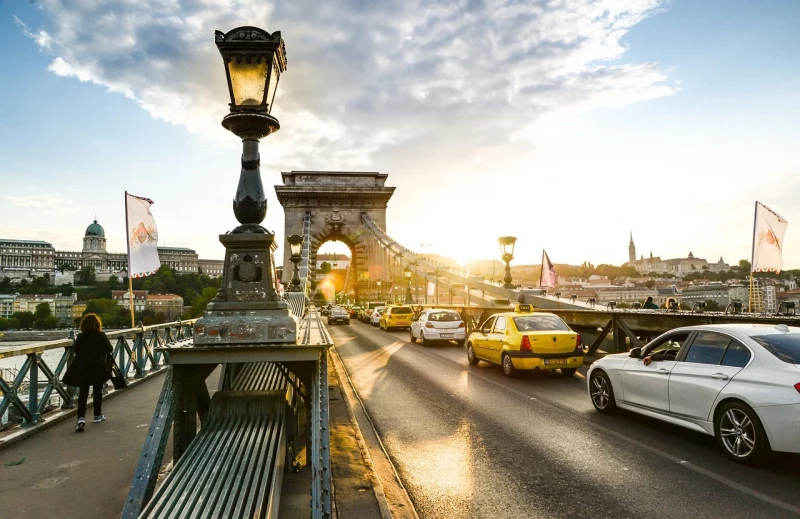
It seems there might be a confusion in the name. The Chain Bridge in Budapest is known as "Széchenyi lánchíd" in Hungarian, which translates to Széchenyi Chain Bridge in English. It is one of the iconic landmarks of Budapest, Hungary, and it spans the Danube River, connecting the Buda and Pest sides of the city.
The Chain Bridge was completed in 1849 and was the first permanent bridge across the Danube in Budapest. It played a significant role in the unification of Buda and Pest, which were separate cities at the time. The bridge is named after Count István Széchenyi, a key supporter of its construction.
The Széchenyi Chain Bridge is not only an important transportation link but also a popular tourist attraction, offering stunning views of the Danube River and the Budapest skyline. The bridge is particularly enchanting when illuminated at night.
3 - Visit Heroes’ Square
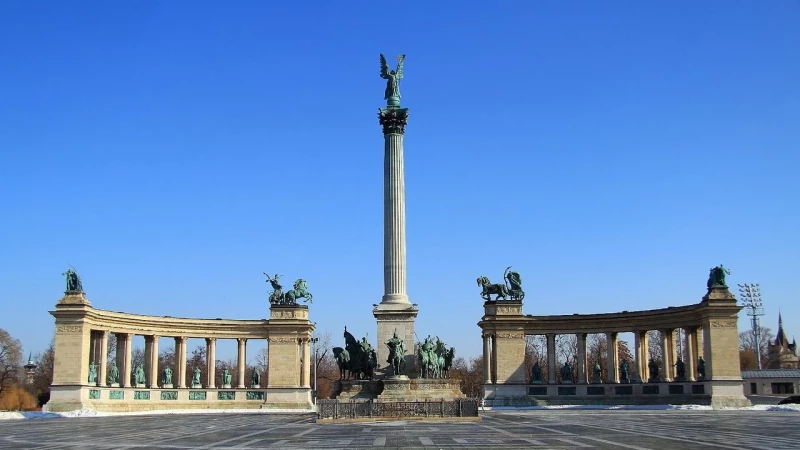
Visiting Heroes' Square in Budapest is a must for anyone exploring the city's rich history and architectural beauty. Located at the end of Andrassy Avenue, it stands as one of Budapest's most iconic landmarks. Here's what you can expect during your visit:
-
Monuments and Statues: Dominating the square is the Millennium Monument, erected in 1896 to commemorate the millennium of the arrival of the Magyars in the Carpathian Basin. You'll find statues of historical Hungarian figures, from tribal chiefs to great kings and leaders.
-
Museums: Two significant museums flank the square—the Museum of Fine Arts, housing an impressive collection of European art, and the Budapest History Museum, tracing the city's history from its beginnings to the present day.
-
City Park: Just behind the square lies City Park (Városliget), a vast green space ideal for strolling, cycling, or simply relaxing. Other attractions within the park include Vajdahunyad Castle, Budapest Zoo, and Széchenyi Baths.
-
Events and Festivals: Heroes' Square frequently hosts cultural events and festivals, especially during the summer months. Outdoor concerts, food festivals, and traditional performances are commonly organized here.
-
Photography: The square provides excellent photo opportunities, whether you're capturing the imposing Millennium Monument, the statues, or simply the vibrant atmosphere of this historic square.
In summary, Heroes' Square is a must-visit in Budapest, offering a unique blend of history, culture, and relaxation in a stunning setting. Make the most of your time there!
4 - Relax in thermal baths, such as Széchenyi or Gellért
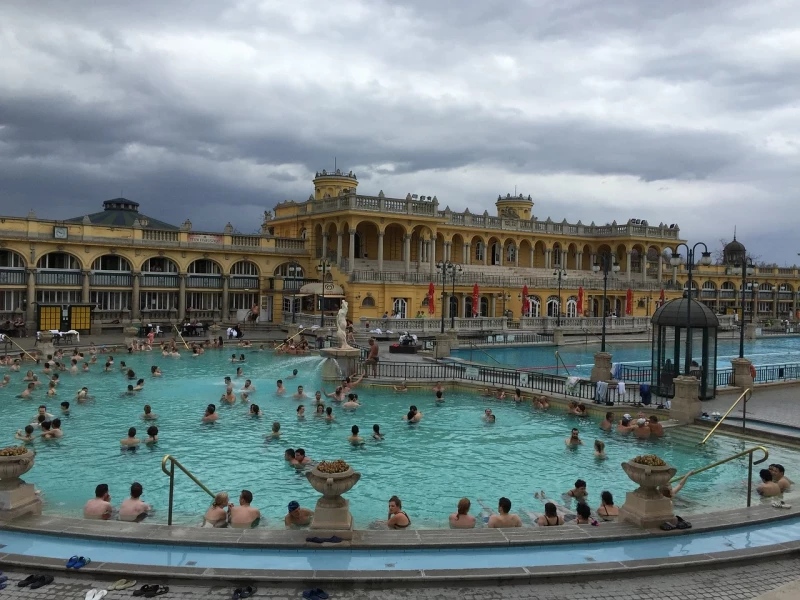
The thermal baths in Budapest are renowned worldwide for their natural thermal waters and magnificent facilities. Here are some of the most famous thermal baths in Budapest that you might consider visiting:
-
Széchenyi Baths: Located in City Park (Városliget), Széchenyi Baths are the largest thermal baths in Europe. They offer a variety of indoor and outdoor pools with different water temperatures, saunas, and steam rooms. It's an ideal place to relax year-round.
-
Gellért Baths: Situated in the Gellért Hotel, the Gellért Baths are famous for their spectacular Art Nouveau architecture. Indoor and outdoor pools, Turkish baths, saunas, and spa treatments make this location a luxurious experience.
-
Rudas Baths: Dating back to the Ottoman era, Rudas Baths are known for their stone dome and thermal pools. They provide a unique experience with traditional Turkish baths and a rooftop pool offering panoramic views of Budapest.
-
Lukács Baths: These baths are appreciated for their mineral-rich thermal waters. They are less touristy than some others, providing a more local and authentic atmosphere. Facilities include indoor and outdoor pools, saunas, and health services.
-
Király Baths: Also of Ottoman origin, Király Baths are famous for their stone domes and traditional thermal baths. It's a smaller and more intimate place compared to some other baths, offering a quieter experience.
When visiting Budapest, taking the time to relax in one of these thermal baths is a must. Each has its distinct charm, providing a soothing getaway after a day of exploring the city.
 Our tips for getting the most out of your experience.
Our tips for getting the most out of your experience.
Relaxing in the thermal baths in Budapest can be a highly enjoyable experience. Here are some tips to make your visit even more relaxing:
-
Choose the right time: Thermal baths are often quieter in the morning on weekdays. Avoid peak hours, especially in the late afternoon, to enjoy a more tranquil atmosphere.
-
Rent a cabin: For added privacy, you can rent an individual cabin. This provides you with a space to change and store your belongings in peace.
-
Try different pools: Thermal baths often have several pools with different temperatures. Try them all to find the one that suits you best and contributes most to your relaxation.
-
Enjoy the facilities: In addition to thermal pools, explore saunas, steam rooms, and relaxation areas. Each facility has its own health benefits and can contribute to your overall relaxation.
-
Indulge in spa treatments: Many thermal baths offer spa services, such as massages and wellness treatments. Book in advance if possible to secure a time that suits you.
-
Stay hydrated: It's crucial to stay hydrated, especially if you're using heat facilities like saunas. Bring a water bottle with you and drink regularly.
-
Bring flip-flops and a towel: Some facilities may require specific footwear, and a towel is often necessary for sitting or lying down. Make sure to have these items with you.
-
Respect the rules: Thermal baths often have specific rules, such as taking a shower before entering the pools. Ensure that you follow these rules to maintain a relaxing atmosphere for everyone.
By following these tips, you'll maximize your relaxation experience in the thermal baths in Budapest and fully enjoy the benefits of these natural hot springs.
5 - Explore the Great Covered Market (Nagycsarnok)
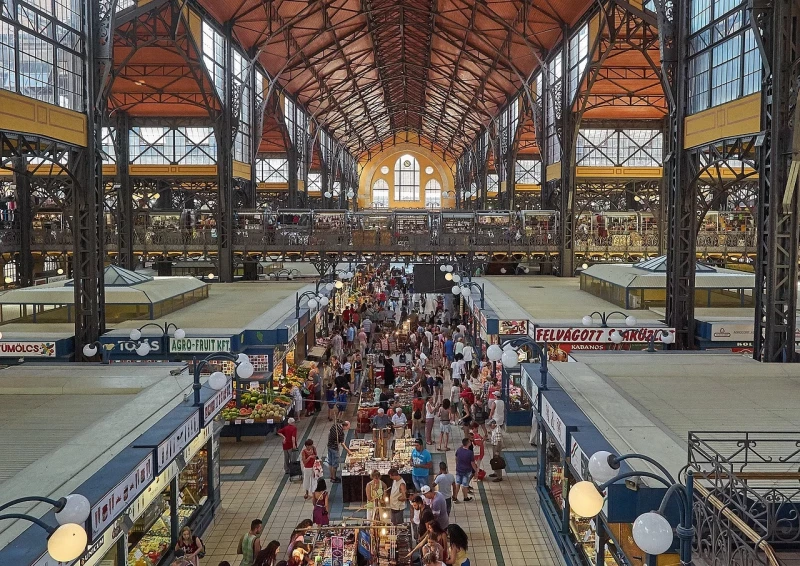
The Great Market Hall, or Nagycsarnok in Hungarian, is one of Budapest's most iconic markets. Here's what you can expect during your visit:
-
Impressive Architecture: The building itself is a work of art. Designed by Hungarian architect Samu Pecz, the Great Market Hall features a neo-Gothic style, with Zsolnay tiles on the façades and a colorful metal roof. The architecture is stunning both inside and out.
-
Fresh and Local Products: Inside the market, you'll find a wide variety of fresh produce such as fruits, vegetables, meat, fish, and dairy. It's an excellent place to taste authentic Hungarian cuisine and buy local ingredients.
-
Handcrafted Goods and Souvenirs: In addition to food items, the market offers a range of handcrafted goods, souvenirs, and household items. It's an ideal place to purchase unique gifts and explore Hungarian craftsmanship.
-
Hungarian Cuisine: The market also houses several stands and small shops selling traditional Hungarian dishes such as sausages, goulash, and pastries. It's a perfect opportunity to savor delicious local cuisine.
-
Lively Atmosphere: The market is often bustling with locals and tourists alike. The vibrant and colorful atmosphere creates a unique shopping experience.
-
Upper Floors: While most visitors focus on the ground floor, there are also galleries on the upper floors offering similar products with often fewer crowds. It's a great place to explore and take photos of the bustling activity below.
-
Operating Hours: Make sure to check the market's opening hours before your visit, as they may vary depending on the day of the week and the season.
The Great Market Hall is not just a place for commerce but also a cultural attraction where you can immerse yourself in Budapest's daily life and discover the richness of Hungarian gastronomy.
 Our tips for getting the most out of your experience.
Our tips for getting the most out of your experience.
Navigating the Great Market Hall (Nagycsarnok) in Budapest can be an exciting experience. Here are some tips to make your exploration more enjoyable:
-
Arrive Early: If possible, visit the market early in the day to avoid large crowds. This is especially true if you plan to take photos or want a more relaxed shopping experience.
-
Weekday Visits: Weekdays tend to be less crowded compared to weekends. If you have flexibility in your schedule, consider planning your visit on a weekday.
-
Take Your Time: The market is a vast space with numerous stalls and sections. Allocate enough time to explore at a leisurely pace, allowing you to fully enjoy the variety of products and experiences.
-
Start on the Ground Floor: Begin your exploration on the ground floor, where you'll find a wide array of fresh produce, meats, and dairy products. This is the heart of the market and a great place to start your culinary journey.
-
Explore the Upper Floors: Venture to the upper floors for handcrafted goods, souvenirs, and perhaps a quieter atmosphere. You may find unique items and experience a different side of the market.
-
Try Local Cuisine: Don't miss the chance to taste traditional Hungarian dishes offered by the market's food vendors. Goulash, sausages, and pastries are among the local specialties you can savor.
-
Bring Cash: While some vendors may accept credit cards, it's advisable to have some cash on hand, especially for smaller purchases. ATMs are available nearby if needed.
-
Bargain Responsibly: Bargaining is not a common practice in Hungarian markets, but you can politely inquire about discounts or bundle deals, particularly when purchasing multiple items.
-
Engage with Vendors: Many vendors are friendly and open to conversation. If you have questions about their products or want recommendations, don't hesitate to ask. It can enhance your overall market experience.
-
Check Opening Hours: Confirm the market's opening hours before your visit, as they may vary. Some vendors may close earlier than the official closing time, so arriving well before the closing hour ensures you have ample time to explore.
By following these tips, you can make the most of your visit to the Great Market Hall, enjoying the rich offerings and vibrant atmosphere of this iconic Budapest market.
6 - Discover the Dohány Street Synagogue and the Jewish Quarter
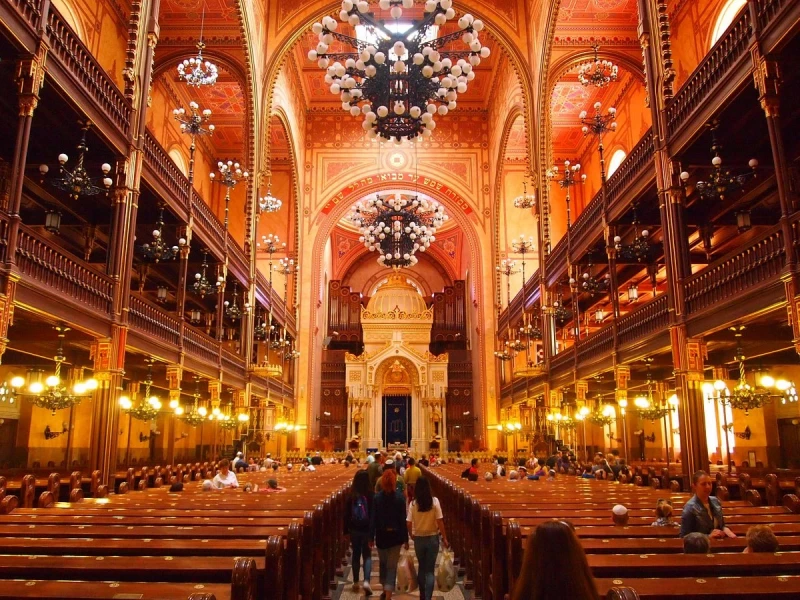
The Dohány Street Synagogue, also known as the Great Synagogue or the Great Synagogue of Budapest, is one of the main synagogues in Budapest, Hungary. It is located in the Jewish quarter of the city, also known as the seventh district. Here is some information about the synagogue and the Jewish quarter:
-
Dohány Street Synagogue:
- The synagogue was built in the mid-19th century and was inaugurated in 1859.
- It is the largest synagogue in Europe and the second largest in the world, after the Temple Emanu-El synagogue in New York.
- The architecture of the synagogue is a mix of styles, including Moorish, neo-Romanesque, and Gothic elements.
- The building also houses the Jewish Museum of Budapest and a memorial cemetery dedicated to Hungarian Jews who perished during the Holocaust.
-
Jewish Quarter of Budapest:
- The Jewish quarter of Budapest, also known as District VII, historically served as the heart of the Jewish community in the city.
- Before World War II, it was a vibrant center of Jewish life with numerous synagogues, schools, shops, and cultural institutions.
- During World War II, the Jewish community in Budapest suffered greatly due to anti-Semitic laws and the Holocaust.
- After the war, the district was neglected for many years but has experienced a revival in recent decades, becoming a trendy neighborhood with cafes, bars, art galleries, and a vibrant cultural atmosphere.
-
Cultural and Touristic Role:
- The Dohány Street Synagogue is now a major tourist attraction in Budapest, drawing visitors due to its historical and architectural significance.
- The Jewish quarter has also become a lively nightlife hub, with many ruin bars, which are former abandoned buildings transformed into entertainment spaces.
The Dohány Street Synagogue and the Jewish quarter of Budapest are significant elements of the city's cultural heritage, reminding visitors of the richness of Jewish culture and the historical challenges faced by the community.
 Our tips for getting the most out of your experience.
Our tips for getting the most out of your experience.
If you're looking to explore the Dohány Street Synagogue and the Jewish quarter of Budapest optimally, here are some tips:
-
Guided Tour: Opt for a guided tour of the synagogue. Guides can provide detailed historical information and interesting anecdotes.
-
Combined Tickets: Some tourist sites offer combined tickets, which can be advantageous if you plan to visit other attractions in the area.
-
Respecting Customs: If attending a religious service, make sure to respect the customs and rules of the place of worship.
-
Exploring the Neighborhood: Walk around the Jewish quarter to discover the cobblestone streets, small shops, cafes, and restaurants. It's an excellent way to feel the local atmosphere.
-
Visit the Jewish Museum: Take advantage of your visit to the synagogue to explore the Jewish Museum of Budapest, offering captivating exhibitions on Hungarian Jewish history and culture.
-
Detour to the Memorial Cemetery: If possible, visit the adjacent memorial cemetery to pay homage to the victims of the Holocaust.
-
Meeting the Community: If interested, inquire about community events or local festivals that might be taking place during your visit.
-
Taste Local Cuisine: Enjoy the culinary specialties of the Jewish quarter by visiting local restaurants or markets.
-
Public Transportation: Use public transportation to navigate the neighborhood, allowing you to immerse yourself more in local daily life.
-
Responsible Photography: During your visit, be mindful of photography rules, especially in places of worship, and respect the privacy of local individuals.
By following these tips, you'll maximize your experience while exploring the Dohány Street Synagogue and the Jewish quarter of Budapest, appreciating both the rich cultural history and the unique atmosphere of this part of the city.
7 - Admire the architecture of the Hungarian Parliament.
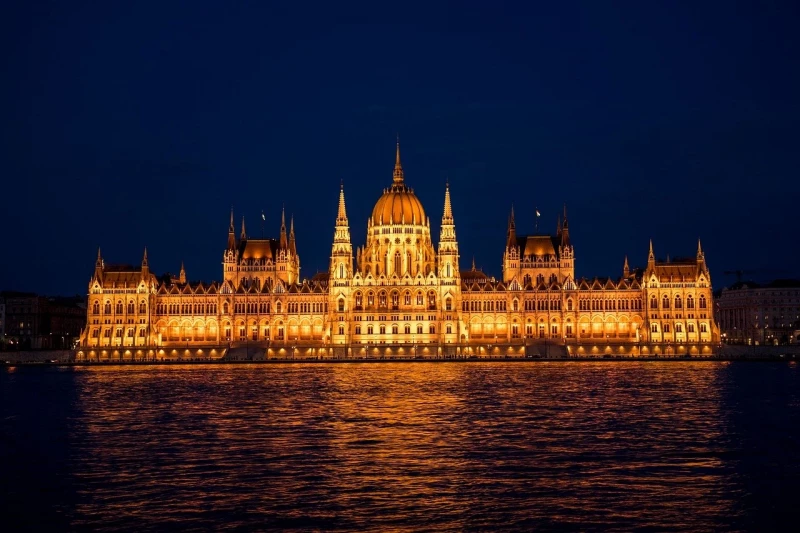
Admiring the architecture of the Hungarian Parliament is a captivating experience. Located on the banks of the Danube River in Budapest, it stands as one of Hungary's most iconic landmarks and is among the largest parliamentary buildings in Europe. Designed by Hungarian architect Imre Steindl, the Parliament was completed in 1902 in a distinctive Neo-Gothic style.
The architectural features of the Hungarian Parliament are awe-inspiring, characterized by ornate facades, pointed arches, towering spires, and intricate details. The building spans nearly 270 meters in length, showcasing remarkable symmetry.
As you take in its grandeur, you'll notice numerous sculptures adorning the facade, depicting historical figures, Hungarian kings, significant personalities, and decorative motifs. Domes and turrets contribute to the overall impression of grandeur and majesty.
At night, the Hungarian Parliament is beautifully illuminated, creating a spectacular view along the Danube River. Whether during the day or night, the architecture of the Hungarian Parliament provides a visually stunning experience and stands out as a highlight of Budapest.
8 - Visit the Cave Church (Sziklatemplom)
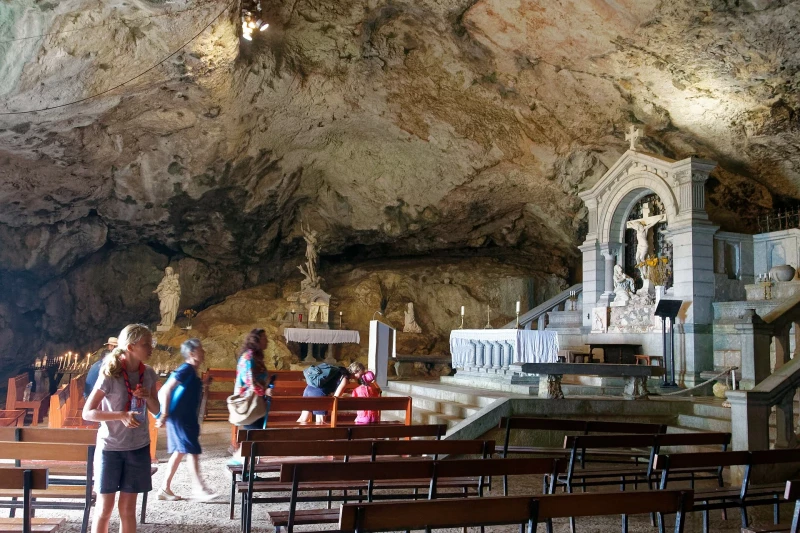
The Cave Church, or Sziklatemplom in Hungarian, is a church located within a natural cave on the side of Gellért Hill in Budapest, Hungary. This church is dedicated to Saint Ignatius of Loyola, the founder of the Jesuit order.
This unique place of worship is integrated into the rock of the hill, giving it a particularly mystical character. The cave has an interesting history, having served various purposes over the centuries. Originally, it was a pagan worship site, and later it was transformed into a medieval hermitage.
The current Cave Church was founded in the 20th century by Jesuit monks. It was carved into the rock and possesses a unique atmosphere of contemplation. Visitors can admire altars and statues inside this picturesque church.
In addition to its spiritual aspect, the location of the Cave Church offers a panoramic view of Budapest from Gellért Hill. It is an intriguing site for history enthusiasts, those interested in religious architecture, and individuals seeking a unique spiritual experience in an unconventional setting.
9 - Gain height at Gellért Hill for the panoramic view
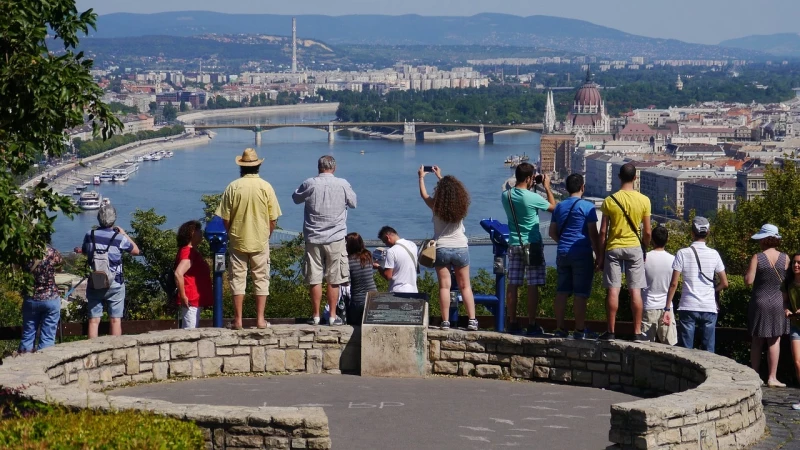
Ascending Gellért Hill in Budapest provides a breathtaking panoramic view of the city and the Danube River. The hill is located on the Buda side of the river and is easily accessible, offering not only stunning vistas but also historical and cultural attractions.
At the top of Gellért Hill, you'll find the Citadel, a fortress built in the 19th century. The Citadel itself offers a commanding view of Budapest and is a popular spot for visitors. From this vantage point, you can admire the iconic landmarks of the city, including the Hungarian Parliament Building, Buda Castle, and the Chain Bridge.
One of the best times to visit Gellért Hill is during sunset when the city is bathed in warm hues, creating a magical atmosphere. The winding paths leading to the top are surrounded by greenery, providing a pleasant and scenic walk.
Apart from the Citadel, the hill is home to the Gellért Hill Cave, which houses the Chapel of St. Ivan. Exploring the surroundings allows you to appreciate not only the natural beauty but also the historical and cultural significance of Gellért Hill.
Taking in the panoramic view from Gellért Hill is a must for anyone visiting Budapest, offering a memorable experience and fantastic photo opportunities.
10 - Spend time on Margaret Island to relax
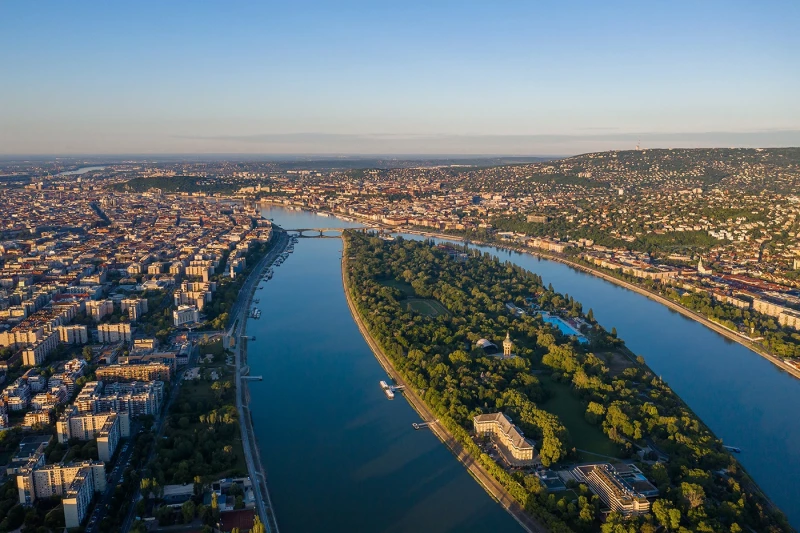
Spending time on Margaret Island, also known as Margitsziget in Hungarian, is a wonderful way to relax in Budapest. This tranquil island in the middle of the Danube River provides a green escape from the bustling pace of the city. Here are some relaxing activities you can enjoy on Margaret Island:
-
Stroll in the Gardens: The island is adorned with well-maintained gardens, perfect for a leisurely stroll. Explore shaded pathways, admire the flowers, and enjoy the fresh air.
-
Thermal Baths: The Palatinus Baths on the island offer a soothing thermal experience. Outdoor thermal baths are especially enjoyable, especially in the summer.
-
Bike Rental: Explore the island by bike for a relaxing experience. Cycling paths wind through the trees, providing a beautiful ride.
-
Picnic: Bring a blanket, some snacks, and enjoy a quiet picnic. There are several dedicated areas where you can comfortably set up.
-
Music and Shows: Margaret Island occasionally hosts outdoor concerts and other performances. Check the local schedule to see if there are any special events during your visit.
-
Cultural Exploration: Visit sites such as the musical fountain, water tower, or the Dominican church for a relaxed cultural experience.
-
Sports and Recreation: If you're interested in more active pursuits, the island offers sports facilities such as tennis courts, jogging tracks, and outdoor fitness areas.
Whether you choose to relax by strolling through the gardens, cycling, or enjoying the thermal baths, Margaret Island provides a natural retreat in the heart of Budapest, ideal for rejuvenation.
11 - Take a cruise on the Danube to see the illuminated monuments
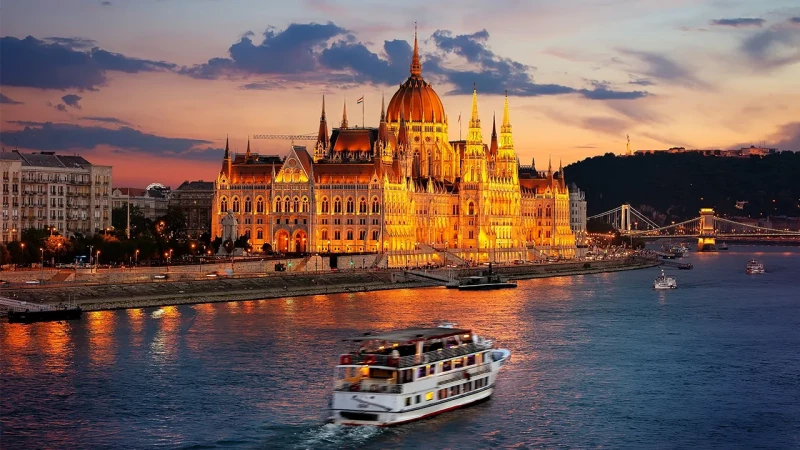
Taking a cruise on the Danube to see the illuminated monuments is an unforgettable experience in Budapest. Here's what you can expect from this nighttime adventure:
-
Panoramic Views of Monuments: A Danube cruise provides a unique perspective on Budapest's iconic landmarks, such as the Hungarian Parliament, Buda Castle, the Chain Bridge, and other historical buildings, all beautifully lit up.
-
Romantic Atmosphere: Danube cruises often come with a romantic ambiance, making it an ideal activity for couples. The sparkling city lights add a magical touch to the evening ride.
-
Comfort and Relaxation: Most cruises offer comfortable amenities, with well-appointed boats, cozy seating, and sometimes even meals or snacks onboard. It's a relaxing way to take in the city's beauty while being on the water.
-
Informative Guidance: Some cruises provide live or recorded commentary that informs you about the history and interesting facts related to the monuments you see along the route.
-
Live Music: Some cruises also feature live musical performances, adding an artistic dimension to your nighttime Danube experience.
-
View of the Illuminated Chain Bridge: The sight of the illuminated Chain Bridge, another stunning feature at night, is particularly spectacular from the Danube. You'll enjoy this iconic symbol of Budapest in all its nighttime splendor.
Make sure to check the available cruise options and book in advance, especially if you're interested in a dinner cruise. It's a magical and relaxing way to discover the beauty of Budapest from a different perspective.
12 - Experience the unique nightlife of ruin bars, like Szimpla Kert
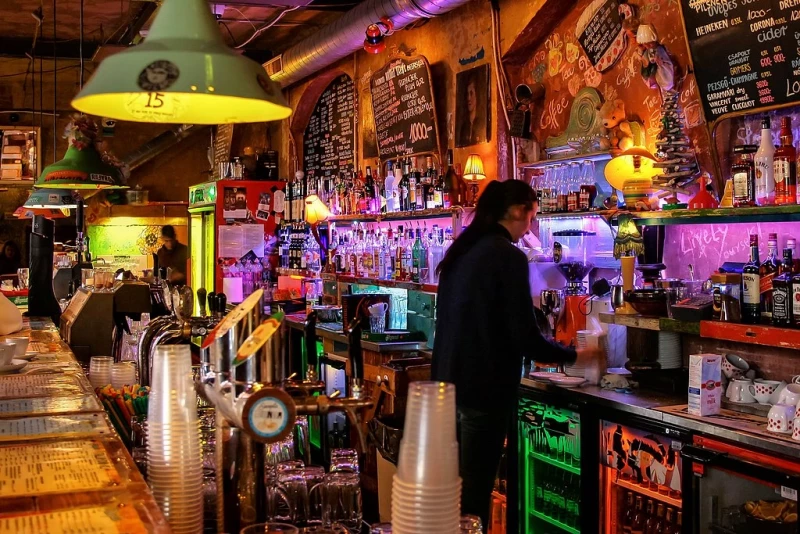
Ruin bars are establishments set up in abandoned buildings or courtyards, creating an alternative, artistic, and laid-back atmosphere. Here's what you can expect when exploring the nightlife of these distinctive places:
-
Bohemian Atmosphere: Ruin bars, like Szimpla Kert, are known for their laid-back bohemian atmosphere. These places are often decorated with eclectic objects, quirky artwork, and an overall diverse aesthetic.
-
Musical Diversity: Ruin bar nightlife offers musical diversity, ranging from electro DJ sets to live performances by local bands. You can expect a varied musical lineup that attracts a diverse audience.
-
Unique Spaces: Each ruin bar has its own charm, with unique indoor and outdoor spaces. Some feature cozy lounges, rooftop terraces, green inner courtyards, or even underground dance floors.
-
Cultural Encounters: Ruin bars serve as meeting places for locals and travelers, providing a unique opportunity to experience Budapest's alternative culture. People come here to socialize, enjoy music, and soak in the lively atmosphere.
-
Creative Cocktails: Ruin bars often showcase creativity in their drinks, offering original cocktails and local beverages. It's the perfect place to taste unique flavors and experiment with new concoctions.
-
Artistic Events: Some ruin bars organize special events, such as outdoor film screenings, temporary art exhibitions, themed parties, or even vintage markets.
Szimpla Kert, one of Budapest's most iconic ruin bars, is an excellent starting point to dive into this unique nightlife scene. Make sure to let yourself be carried away by the creative energy and friendliness of these singular places.
13 - Enjoy a performance at the Hungarian State Opera
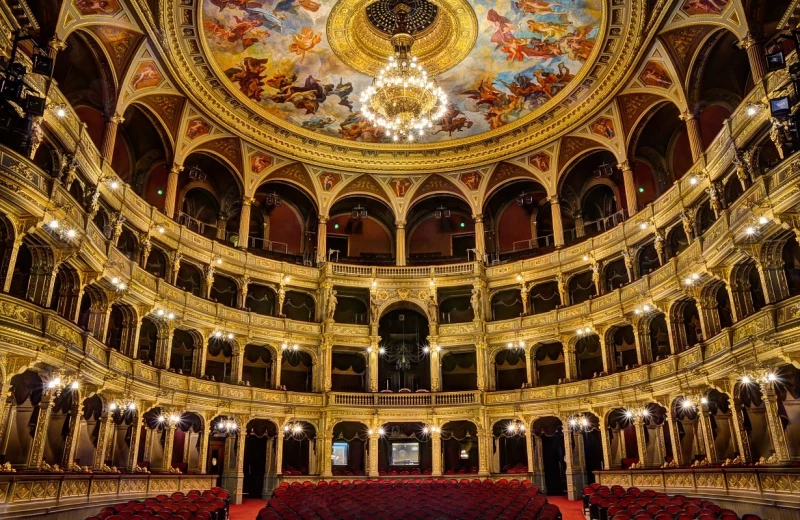
Enjoying a performance at the Hungarian State Opera is a refined cultural experience in Budapest. Here's what you can expect when visiting this prestigious venue:
-
Magnificent Architecture: The Hungarian State Opera is renowned for its impressive architecture. Designed by Miklós Ybl, the building is a striking example of Neo-Renaissance style. The opulent interior is adorned with lavish decor, creating an elegant atmosphere.
-
World-Class Performances: The Hungarian State Opera is known for its world-class productions, ranging from classical operas to ballets. Talented artists grace the stage, delivering captivating performances that appeal to classical music and dance enthusiasts alike.
-
Diverse Repertoire: The repertoire of the Hungarian State Opera is diverse, covering a wide range of classical and contemporary works. From beloved operas by Mozart, Verdi, and Puccini to timeless ballets, there's something for every taste.
-
Elegant Atmosphere: Attending a performance at the Hungarian State Opera provides an opportunity to experience cultural enrichment in an elegant atmosphere. Audiences often dress formally, adding to the refined ambiance.
-
Cultural History: The Hungarian State Opera is a venue steeped in cultural history. It's a place where Hungarian artistic tradition has flourished for decades, offering visitors an immersion into the cultural richness of the country.
-
Artistic Excellence: The company of the Hungarian State Opera is known for its artistic excellence. Renowned conductors, talented choreographers, and exceptional singers contribute to the institution's reputation.
Attending a performance at the Hungarian State Opera is an immersive cultural experience that allows you to witness the grandeur of operatic art in an exceptional setting. Be sure to check the schedule in advance and secure your tickets for a memorable evening.
Budapest - Where to Stay?
For an optimal experience visiting Budapest, you might consider staying in one of the following neighborhoods, depending on your preferences and interests:
-
Castle District (Várkerület): Offering a medieval atmosphere, picturesque alleys, and stunning city views, the Castle District is ideal for those seeking a historical ambiance.
-
Downtown (Belváros-Lipótváros): Near the Danube and Parliament, downtown is perfect for urban enthusiasts, with restaurants, shops, and tourist attractions in close proximity.
-
Jewish Quarter (Erzsébetváros): Known for its vibrant nightlife, ruin bars, and cultural history, this area is great for those wanting to explore Budapest's artistic and social scene.
-
Gellért Hill (Gellérthegy): If you're looking for a quieter atmosphere with panoramic views, Gellért Hill provides a peaceful retreat while being close to major attractions.
-
Bath District (Terézváros): Close to the famous Széchenyi Baths, staying in this area allows you to easily enjoy thermal benefits while being well-connected to the rest of the city.
-
Theater District (Újlipótváros): If you're a culture and entertainment enthusiast, this neighborhood is known for its theaters, art galleries, and creative atmosphere.
-
Margaret Island (Margitsziget): For a green retreat in the middle of the Danube, Margaret Island offers a tranquil refuge while staying close to the city center.
Each of these neighborhoods has its own distinct charm, so choose the one that best fits your preferences and travel style.
Budapest - How to get around?
Budapest offers various means of transportation to facilitate city exploration:
-
Metro: Budapest has an efficient metro system with four lines (M1, M2, M3, M4) covering key areas of the city. The metro is ideal for quickly moving between neighborhoods.
-
Trams: Trams provide a picturesque way to discover the city. Several lines traverse main streets, offering pleasant views of landmarks and daily life.
-
Buses: The bus network is extensive and complements the metro and tram systems, allowing access to areas not directly served by other modes of transportation.
-
Danube River Boat: The Danube River runs through Budapest, and boat services offer tourist cruises. You can also use ferry services to cross the river.
-
Bicycles: Budapest is becoming more bike-friendly, with dedicated bike lanes and bike rental services. It's an excellent way to explore the city at your own pace.
-
Taxis and Ride-Sharing Services: Taxis are readily available, but be sure to use official taxis. Ride-sharing services like Uber or Bolt are also popular and convenient.
-
Walking: Many of Budapest's tourist sites are concentrated in the city center. Exploring on foot allows you to fully experience the architecture, charming streets, and the unique atmosphere of the city.
Choose your mode of transportation based on the distance you need to cover and your personal preferences. By combining these options, you can make the most of your visit to Budapest
Budapest - Best period
Budapest offers a charming experience throughout the year, but the best time to visit depends on your preferences for weather and activities. Here's an overview of the seasons in Budapest:
-
Spring (March to May): Temperatures start to warm up, with pleasant days. Parks and gardens are in bloom, and cultural festivals begin to liven up the city.
-
Summer (June to August): Budapest is bustling during the summer, with long sunny days and warm temperatures. It's the perfect time to enjoy outdoor festivals, thermal baths, and Danube River cruises.
-
Autumn (September to November): Temperatures remain pleasant in early autumn, and the city is adorned with autumn colors. It's also a season for cultural events, grape harvesting, and festivals.
-
Winter (December to February): Christmas markets add a magical atmosphere to Budapest during the winter season. While temperatures are cooler, it's an ideal time to enjoy thermal baths and indoor activities.
Keep in mind that July and August are the peak tourist months, while the spring and autumn periods offer a balance of pleasant weather and moderate tourist crowds. Depending on your personal preferences, choose the season that aligns best with what you're looking for during your visit to Budapest.
